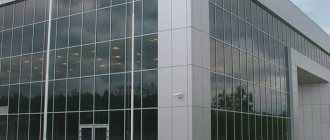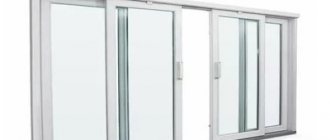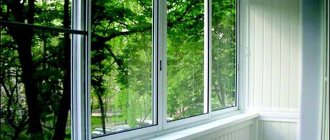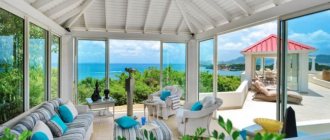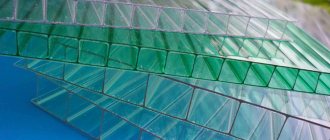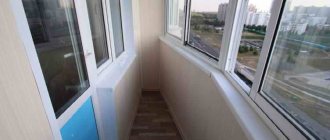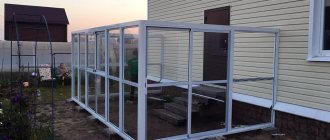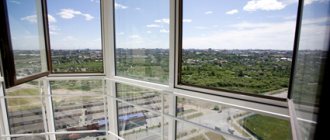Cold glazing of the veranda at the dacha will protect the room from dampness, cold and drafts. An aluminum profile is used, so the construction cost is low. At the same time, the sealing is not one hundred percent - in the cold months the temperature in the room will be lower than in the living rooms in the house.
from 6,200 ₽/m2
Order
Our advantages
Official Provedal dealer
Safe for health
In any RAL color
Compact and lightweight
Durable
Any architectural forms
Veranda
This room is built into or attached to the house and is usually not heated. With the help of frameless glazing of the veranda with an aluminum profile, its protection from external factors and a panoramic view of the territory are achieved. Sometimes there is a residential area here - in this case it is better to install a warm profile system.
Terrace
This extension to the house is built on an elevation, located along the perimeter of the building, adjacent to the front or end. Sliding glazing of the terraces provides maximum illumination, panoramic views, convenient opening of windows and doors as a compartment or sliding to the side.
Alcove
Lightweight aluminum profiles are suitable for cold glazing of gazebos. The structures are equipped with multi-chamber double-glazed windows and are resistant to wind loads and climatic factors. For winter operation, systems with a thermal insert that blocks the cold are selected.
Available solutions
Depending on the type of glass used, cold glazing of a veranda at the dacha may include single, double and energy-saving double-glazed windows. Aluminum profile windows can be hinged or sliding:
- When installing swing structures, it is necessary to take into account the convenience of opening the doors. Such windows are a classic glazing option and can reduce heat loss.
- Sliding windows move along and do not require additional space to open. The solution is popular and in demand due to its increased functionality and practicality.
Types of glazing of verandas and terraces
Cold
In rooms that will be used only in the warm season, it is advisable to install cold profiles. They are equipped with single-chamber double-glazed windows or single glass, preventing freezing of the veranda or gazebo even at sub-zero temperatures.
Warm
When warmly glazing a veranda with an aluminum profile, a system with thermal breaks and multi-chamber double-glazed windows are used. They create a comfortable temperature inside even when the temperature outside is low. If heating is available, the room can be used all year round.
Options for aluminum structures for verandas
There are many options for aluminum structures. Most often they resort to the equipment of sliding systems.
Windows can be moved using one of three technologies:
- "Accordion" . After pressing, the first leaf folds at an angle of 90°. In the same way, the following fragments are gradually folded. As a result, all the sashes are tightly assembled at the edge of the window opening.
- Coupe . Installation with central and full opening is possible.
- Parking . After pressing on the sash (from the side), the frames move to the side, sequentially engaging subsequent fragments.
The second most popular glazing method is sliding systems. This option allows for a wide overview. Using such windows is very simple and convenient. The shift can be made in one or different directions.
Important! Using aluminum profiles, you can glaze openings of any size and configuration.
The option of panoramic glazing is very attractive. Despite the apparent complexity, installation of the structures is simple. This method allows you to achieve maximum visibility and illumination of the room. An interesting way to glaze a country veranda is to insert stained glass instead of glass.
Benefits of glazing
Lightness of designs
Aluminum profiles are lightweight, so they can be installed on any type of foundation without increasing the load on it.
Variety of shapes and sizes
Aluminum glazing of a terrace or gazebo is made to suit any window size, roof shape or type of door.
Easy care
Double-glazed windows and profiles do not require special care - periodic wiping with a damp cloth is sufficient.
Durability
Strong and durable systems do not deform over time, maintaining their original characteristics and color.
Modern look
Designs in which metal is combined with glass look harmonious on the facade of any building and in the interior.
Environmental friendliness
Environmentally friendly materials are used to glaze the terrace with aluminum profiles.
Installation rules
Of course, in order to carry out competent installation of aluminum profiles, certain knowledge will be required. It is better to entrust this matter to specialists. Reputable, experienced companies install quickly and provide a guarantee. It is better to purchase profiles from manufacturers - this way you can purchase the complete set at the best possible price.
Designs from the following manufacturers are popular today:
- Provedal;
- Krauss;
- Vidnal;
- Reynaers;
- Schüco;
- Alutech.
If you install double-glazed windows with aluminum profiles yourself, then you must adhere to the following rules:
- The frames must be installed level. Otherwise, the windows will “lead” and they will not be able to provide proper tightness. When fixing elements, use a spirit level (level).
- The maximum gap between the window block and the opening should be no more than 5.5 mm. If the gap is wider, it must be sealed with foam.
- Frames can be installed without intermediate supports. But the width of the section, in this case, should not be more than 160 cm.
- To attach the structure to the wall, you should use anchor plates fixed with self-tapping screws.
- The inside of the grooves should be treated with silicone sealant.
- After installing the windows, apply sealant around the entire perimeter.
- Window sills for aluminum frames are not a mandatory attribute. It is imperative to produce equipment with ebb tides. This will protect the bottom seam from moisture and prevent the development of mold and harmful microorganisms.
Important! Once installed, aluminum profiles do not require special care. It is enough just to periodically remove dust and dirt from the glass and frames.
How much does it cost to glaze a veranda, terrace or gazebo?
| Name | Price | Note |
| REHAU windows | from RUB 3,714/m2 | With installation |
| PROVEDAL windows | from 2,600 rub./m2 | With installation |
| SLIDORS windows | from 7,000 rub./m2 | With installation |
| Frameless LUMON | from 20,000 rub./m2 | With installation |
| Entrance groups, doors | from 6,925 RUR/m2 | With installation |
| Portals | from 17,500 rub./m2 | With installation |
Our company designs and installs warm or cold glazing in gazebos, verandas or terraces. Double-glazed windows, fittings, and profile type are selected taking into account the seasonal use of small architectural forms. Contact our specialists to clarify the price by phone.
Wooden frames
The material is traditional, has a lot of advantages and one main drawback - wood is of organic origin, which results in all its problems:
- The ability to absorb and release water, while changing linear dimensions.
- Contact with moisture leads to the formation of mold, mildew, and rotting.
- Direct sunlight can cause solid wood to warp or crack.
- Wood burns well.
- Periodic maintenance of profiles is required - impregnation, painting.
- These disadvantages are known to everyone, but they are offset by the advantages of the material, the main one of which is the possibility of self-production or repair.
Construction materials
The glazing frame can be made of plastic, wood and aluminum. The materials are arranged by popularity, starting with the most popular. Of course, at first plastic began to be used everywhere in the glazing of city apartments. Gradually, it migrated to private homes, but wood and aluminum here continue to stubbornly hold their own. This is especially good for wood, which is involuntarily associated with the warm atmosphere of a country house and fits perfectly with the design in the chalet, country, and Provence styles that are so often used in the outback.
Aluminum
The main advantage of aluminum is its light weight. The material allows you to make the structure much lighter, but without compromising its strength. In terms of cost, aluminum also outperforms its main competitors. For comparison: the price of plastic glazing is twice as high as installing a similar aluminum structure. Unfortunately, the material did not become widely used due to its main drawback: the design retains heat very poorly.
A veranda with an aluminum profile can only be used in summer; in winter, it is most logical to install an “outdoor freezer” here. Although now manufacturers offer a rather expensive solution to this problem - thermal inserts and special liners that retain heat and create additional sound insulation. The aluminum profile is fireproof, so the risk of the structure igniting is reduced to zero, which becomes another advantage of the material when compared with wood.
Tree
Previously, only wood was used for glazing houses (not only verandas). With the advent of alternative options, this material began to be slowly forgotten, but its advantages did not fade. Wood has high noise and heat insulation. Although, of course, the glass itself receives the main “blow” in terms of heat conservation, a lot also depends on the frames. Unlike plastic or aluminum, wood does not need additional thermal liners, since the material itself prevents cold from entering the room and warm air from escaping outside. Wood has micropores, which allows it to “breathe”. Manufacturers of plastic double-glazed windows state in their characteristics that the maximum minus for the material is 30 degrees below zero. At this temperature, PVC loses strength and becomes brittle.
For wood, there is also a frost resistance limit, but this figure is so sky-high (minus 120 degrees) that even in the conditions of the Far North it is impossible to verify it. From this we can conclude: wood is the warmest material. The wood is environmentally friendly, but it will catch fire when in contact with an open flame. The material is pre-treated with special impregnations, which increase its fire resistance and moisture resistance. Contact with liquid is dangerous for wood. Material that is not properly processed can become deformed, rendering the double-glazed window completely unusable. And the main advantage of wood lies in its beauty, which neither aluminum nor PVC has. Warm, homely, “cozy” material will ideally highlight the design of an Alpine chalet, simple country, French Provence and rustic Russian style.
Plastic
Contrary to misconceptions, high-quality plastic does not emit harmful substances during operation. PVC retains heat perfectly, thanks to special rubberized inserts around the perimeter of the window and door sashes, the veranda remains airtight. Plastic windows provide good sound insulation. They are ideal for warm glazing, but are heavy, so they are not recommended for use in dilapidated dachas or old country houses. PVC cannot be called fire-resistant, but upon contact with an open flame, they do not catch fire, but begin to melt, releasing caustic substances.
Perhaps the main disadvantage of plastic glazing is its high cost. If you need to install one or two windows, then the purchase and installation will not hit the budget much, but for a panoramic double-glazed window you will have to spend a lot of money. Wood and aluminum leave PVC far behind in this regard, luring buyers with tempting prices.


